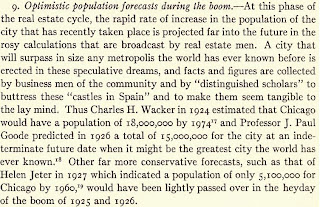Hat tip to Andrew Lainton, who had a post on the work of Homer Hoyt last year explaining how Hoyt's framework for understanding urban real estate cycles dovetails with the asset price increases and decreases in the credit cycle.
You can read Homer Hoyt's text --his PhD thesis-- "One hundred years of land values in Chicago" in its entirety here at archiv.org.
The framework is laid out above in 20 points but here are some highlights with respect to the Canadian real estate cycle which is still in the phase of euphoria and continues to climb a wall of worry.
As the Pacifica Partners table below shows, four of the top ten Google searches for "housing bubble" by city were of Canadian cities. For the Pacifica Partners Housing Bubble chart book click here.
It pays to erect new buildings.
The volume of new construction rises
"Shoestring" financing swells the number of new structures.
The new buildings absorb vacant land: the land boom.
You can read Homer Hoyt's text --his PhD thesis-- "One hundred years of land values in Chicago" in its entirety here at archiv.org.
The framework is laid out above in 20 points but here are some highlights with respect to the Canadian real estate cycle which is still in the phase of euphoria and continues to climb a wall of worry.
As the Pacifica Partners table below shows, four of the top ten Google searches for "housing bubble" by city were of Canadian cities. For the Pacifica Partners Housing Bubble chart book click here.
It pays to erect new buildings.
The volume of new construction rises
The volume of building is stimulated by easy credit.
...not to mention Ponzi style financing
The new buildings absorb vacant land: the land boom.
Anyone who has been in downtown Toronto recently will realize the dearth of parking lots --which continue to disappear as we write.
Optimistic population forecasts during the boom.
As a report last week cited in this article "Downtown Toronto’s pace of population growth triples, outpacing suburbs’ as Echo Boomers flock towards urban centre: report" states:
Since 2000, the report adds, nearly 50,000 condo units had been built, sold and occupied south of Bloor Street; by late 2011, an additional 90,000 had been approved throughout the city, mostly planned in the downtown core.The growth presents a number of challenges, not least of which is transit: “Rising population density, specifically along transit lines, will put serious pressure on the city’s already-strained road and public transit infrastructure,” the report notes.There is also uncertainty as to whether the current trends will hold.
So has the real estate market peaked? Will there be a soft landing or will there be a crash? It doesn't matter as at this point, the probability distribution is already set: for lower growth.
The regulatory oversight of the Canadian banking sector will avoid the banking crises of the past...
 |
| Slide 29 from Richard A. Werner's presentation on "The Quantity Theory of Credit and Some of its Applications" |
...but the debts will not go away for the households. Individuals that have extended themselves by access to credit and exceptionally large mortgages on the liability side still have to service those debts and they must do so with incomes that have by and large not kept pace with their material aspirations and --by extension-- their mortgages.













According to the Ontario government:
ReplyDelete"The Greater Toronto Area (GTA) is projected to be the fastest growing region of the province, with its population increasing by 2.8 million, or 44.6 per cent, to reach almost 9.2 million by 2036. The GTA’s share of provincial population is projected to rise from 47.3 per cent in 2011 to 51.6 per cent in 2036."
http://www.fin.gov.on.ca/en/economy/demographics/projections/
All of these people will need places to live so, the GTA property market will experience strong demand for property. Based on these projections, there is no sign of a bubble here.